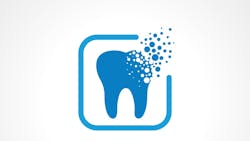The oxidative burst: Friend or foe?
What you'll learn in the article
- How neutrophils use reactive oxygen species (ROS) like superoxide, hydrogen peroxide, hypochlorous acid, and hydroxyl radicals to eliminate microbial threats
- The mechanisms by which neutrophil-derived ROS can damage host tissues and contribute to periodontal disease and chronic inflammation
- The balance between effective immune defense and tissue protection, and how dysregulation can lead to systemic health complications
- Potential strategies for monitoring and managing neutrophil activity to support oral and overall health
Neutrophils are frontline defenders of the innate immune system, rapidly responding to microbial invaders by engulfing and destroying them through a process called phagocytosis. In the bloodstream, neutrophils typically survive for six to 12 hours, while in tissues they can survive roughly 24 to 48 hours.1 After completing their tasks, they are programmed to undergo apoptosis—a form of controlled cell death—to prevent excessive tissue damage from reactive oxygen species (ROS) and proteolytic enzymes they release.
These white blood cells detect, bind to, and internalize pathogens, enclosing them within vesicles called phagosomes. The phagosomes then fuse with granules or lysosomes, releasing a mighty mix of enzymes and toxic substances that kill and digest the microbes.2 A cornerstone of their antimicrobial strategy is the generation of ROS—highly reactive molecules that can be lethal to bacteria, fungi, and viruses.
Additional reading: Is rapamycin the next big breakthrough in periodontitis and oral cancer treatment?
Among the primary ROS generated by neutrophils are superoxide (O₂•⁻), hydrogen peroxide (H₂O₂), hypochlorous acid (HOCl), via myeloperoxidase (MPO), and hydroxyl radical (•OH). During the NADPH oxidase–driven respiratory burst, these oxidants act as microbicidal weapons within phagosomes, but if not tightly controlled they can spill over and cause collateral tissue damage. While essential for microbial killing, these ROS—especially HOCl and •OH—are indiscriminate and can damage host tissues if not contained,3 proving the need for tightly controlled activation and timely resolution of the neutrophil response.
Superoxide (O2•-)
O₂•⁻ is the first ROS generated during the neutrophil respiratory burst. It is produced by the enzyme NADPH oxidase, which transfers an electron from NADPH to molecular oxygen (O₂). Though short-lived, superoxide is important for microbial killing and serves as a precursor to more stable and stronger ROS. Think of superoxide as the neutrophil’s first spark. Two of those sparks can combine—on their own or with help from an enzyme called superoxide dismutase—to make H₂O₂, which lasts longer and acts like a strong disinfectant inside the cell’s “stomach” (phagosome), boosting germ-killing power. While necessary for host defense, extreme or unregulated superoxide production can contribute to oxidative tissue damage.3
Hydrogen peroxide (H2O2): A central but double-edged molecule
H₂O₂ is more stable and membrane-permeable than superoxide, so it acts within the phagosome and can diffuse into surrounding tissues. It is the central substrate for downstream reactions that generate stronger oxidants to enhance microbial killing. At moderate levels it functions as a redox signal in wound healing, apoptosis, and immune modulation; when production exceeds antioxidant defenses during chronic inflammation, it leads to collateral host-tissue damage.4
H₂O₂ can oxidize lipids in cellular membranes, leading to lipid peroxidation, which compromises membrane integrity and promotes cell lysis. Think of many proteins as having tiny sulfur “switches” (thiol groups, –SH). Strong oxidants can lock or break these switches—sometimes forcing wrong sulfur–sulfur links—so the protein warps in shape and stops working (enzymes lose activity; structural proteins weaken). H₂O₂ can induce DNA strand breaks and base modifications, contributing to mutagenesis (a change in DNA sequence) and apoptosis.5
Additional reading: Mitochondrial dysfunction, periodontitis, and systemic disease
In endothelial cells, elevated H₂O₂ increases vascular permeability, promotes adhesion-molecule expression, and disrupts nitric oxide signaling; together, these changes exacerbate inflammation and vascular dysfunction. 6 The tissue-destructive potential of H₂O₂ is further magnified when it participates in reactions that generate more damaging species, particularly hydroxyl radicals through the Fenton reaction, and hypochlorous acid via MPO compounding tissue damage.7
Hypochlorous acid: Myeloperoxidase’s oxidative weapon
One of the defining features of neutrophils is their high content of MPO, a heme enzyme stored in azurophilic (primary) granules—specialized compartments packed with antimicrobial and degradative enzymes.8 MPO uses H₂O₂ to oxidize chloride ions (Cl⁻) in the presence of hydrogen ion (H⁺), producing hypochlorous acid (HOCl), a highly potent microbicidal oxidant.9 HOCl can denature proteins, disrupt microbial membranes, and inactivate bacterial enzymes. It’s the active ingredient in household bleach and is among the most powerful antimicrobial agents produced by the human immune system.
Inside neutrophil phagosomes, HOCl reacts with amino acids, thiols, and nucleotides, rapidly killing pathogens.9 It also activates matrix metalloproteinases (MMPs) and contributes to degradation of the extracellular matrix (ECM).10 In diseases like periodontitis, undue HOCl generation has been linked to gingival inflammation, alveolar bone loss, and destruction of the periodontal ligament.10 Beyond local damage, HOCl-modified proteins can trigger autoimmune responses and amplify inflammatory signaling, extending tissue injury.
Hydroxyl radical (•OH): Uncontrolled but highly reactive
•OH are among the most damaging ROS generated during the Fenton reaction, which occurs when H₂O₂ reacts with transition metal ions like ferrous iron (Fe2+). These •OH molecules are extremely reactive, causing immediate and nonspecific damage to DNA (including strand breaks and base modifications), proteins (oxidation of amino acids), and lipids (peroxidation). Since no enzymatic defense system exists to neutralize them once formed, their production is strictly regulated.11 In inflamed tissues—like those affected by chronic periodontitis—elevated levels of H₂O₂ and free iron promote •OH formation.
Studies have shown that •OH directly contributes to periodontal tissue breakdown. In vitro, hydroxyl radicals denature collagen and disrupt fibroblast-mediated matrix remodeling; in periodontal ligament fibroblasts, ROS (e.g., H₂O₂) alter MMP-driven pathways and impair cell function—mechanisms that contribute to periodontal ECM degradation and disease progression.12 Chronic OS disrupts the balance between oxidants and antioxidants, worsening inflammation, tissue resorption, and further ROS production in periodontal pockets.
Neutrophil-derived ROS are double-edged: essential for killing microbes yet capable of injuring host tissues. In periodontitis, chronic neutrophil activation and oxidative stress drive collagen breakdown and alveolar bone loss; similar ROS-mediated damage accelerates rheumatoid arthritis, COPD, and atherosclerosis. Antioxidant defenses (catalase, glutathione peroxidase, vitamins C/E) usually restrain this, but when overwhelmed, H₂O₂ and downstream oxidants accumulate and amplify inflammation.13 Looking ahead, quantifying neutrophil burden and activation could provide a practical biomarker for earlier detection, risk stratification, and therapy monitoring.
Editor's note: This article appeared in the November/December 2025 print edition of RDH magazine. Dental hygienists in North America are eligible for a complimentary print subscription. Sign up here.
References
- Manoharan RR, Zachová K, Buzáš M, Pospíšil P, Křupka M, Prasad A. NADPH oxidase-dependent free radical generation and protein adduct formation in neutrophils. RSC Adv. 2024;14(34):24765-24780. doi:10.1039/d4ra02739f
- Burn GL, Foti A, Marsman G, Patel DF, Zychlinsky A. The neutrophil. Immunity. 2021;54(7):1377-1391. doi:10.1016/j.immuni.2021.06.006
- Winterbourn CC, Kettle AJ, Hampton MB. Reactive oxygen species and neutrophil function. Annu Rev Biochem. 2016;85:765-792. doi:10.1146/annurev-biochem-060815-014442
- Schultz C. Challenges in studying phospholipid signaling. Nat Chem Biol. 2010;6(7):473-475. doi:10.1038/nchembio.389
- Reed TT. Lipid peroxidation in neurogenerative disease. Free Radic Biol Med. 2011;51(7):1302-1319. doi:10.1016/j.freeradbiomed.2011.06.027
- Kumar V, Sharma A. Neutrophils: Cinderella of innate immune system. Int Immunopharmacol. 2010;10(11):1325-1334. doi:10.1016/j.intimp.2010.08.012
- Kehrer JP. The Haber-Weiss reaction and mechanisms of toxicity. Toxicology. 2000;149(1):43-50. doi:10.1016/s0300-483x(00)00231-6
- Klebanoff SJ. Myeloperoxidase: contribution to the microbicidal activity of intact leukocytes. Science. 1970;169(3950):1095-1097. doi:10.1126/science.169.3950.1095
- Davies MJ. Myeloperoxidase-derived oxidation: mechanisms of biological damage and its prevention. J Clin Biochem Nutr. 2011;48(1):8-19. doi:10.3164/jcbn.11-006FR
- Hasturk H, Kantarci A, Van Dyke TE. Oral inflammatory diseases and systemic inflammation: role of the macrophage. Front Immunol. 2012;3:118. doi:10.3389/fimmu.2012.00118
- Patil RT, Dhadse PV, Salian SS, Punse SD. Role of oxidative stress in periodontal diseases. Cureus. 2024;16(5):e60779. doi:10.7759/cureus.60779
- Arisawa S, Arisawa T, Ohashi M, Nitta Y, Ikeya T, Asai J. Effect of the hydroxyl radical on fibroblast-mediated collagen remodelling in vitro. Clin Exp Pharmacol Physiol. 1996;23(3):222-228. doi:10.1111/j.1440-1681.1996.tb02600.x
- Vo TTT, Chu PM, Tuan VP, Te JSL, Lee IT. The promising role of antioxidant phytochemicals in the prevention and treatment of periodontal disease via the inhibition of oxidative stress pathways: updated insights. Antioxidants (Basel). 2020;9(12):1211. doi:10.3390/antiox9121211
About the Author

Anne O. Rice, BS, RDH, CDP, FAAOSH
Anne O. Rice, BS, RDH, CDP, FAAOSH, founded Oral Systemic Seminars after over 35 years of clinical practice and is passionate about educating the community on modifiable risk factors for dementia and their relationship to dentistry. She is a certified dementia practitioner, a longevity specialist, a fellow with AAOSH, and has consulted for Weill Cornell Alzheimer’s Prevention Clinic, FAU, and Atria Institute. Reach out to Anne at anneorice.com.
